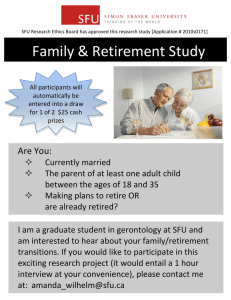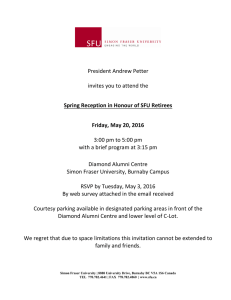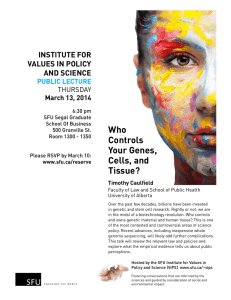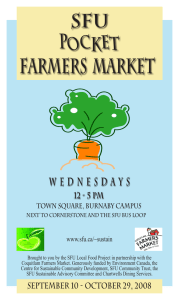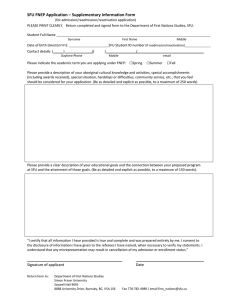The University was named after explorer
advertisement
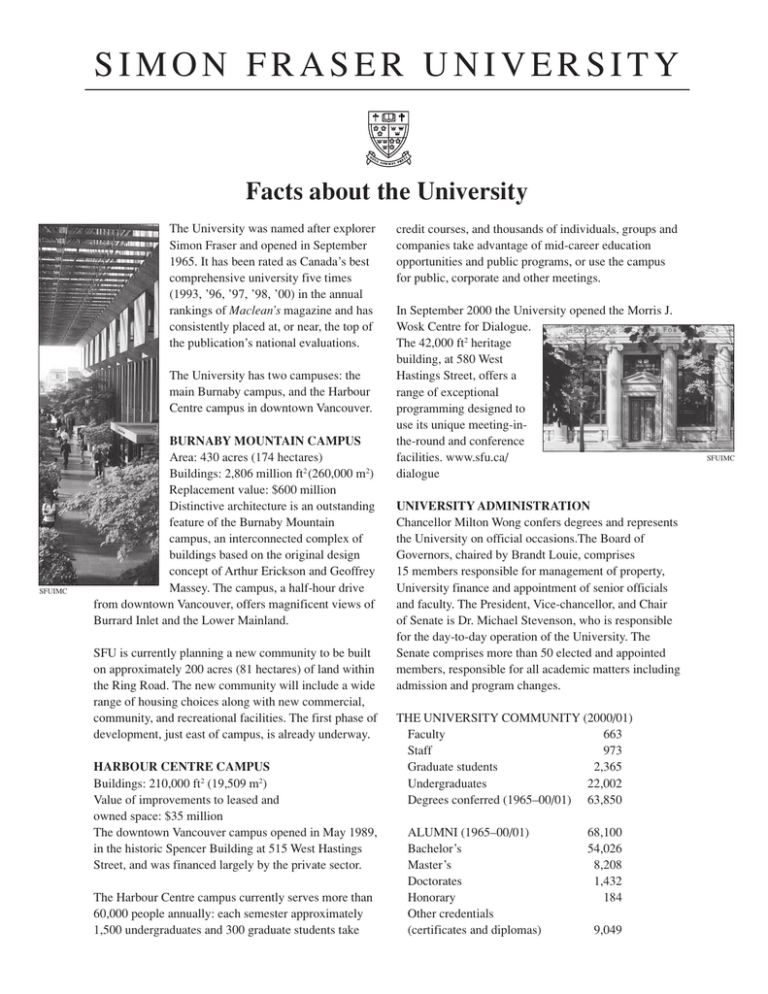
SIMON FRASER UNIVERSITY Facts about the University The University was named after explorer Simon Fraser and opened in September 1965. It has been rated as Canada’s best comprehensive university five times (1993, ’96, ’97, ’98, ’00) in the annual rankings of Maclean’s magazine and has consistently placed at, or near, the top of the publication’s national evaluations. The University has two campuses: the main Burnaby campus, and the Harbour Centre campus in downtown Vancouver. SFUIMC BURNABY MOUNTAIN CAMPUS Area: 430 acres (174 hectares) Buildings: 2,806 million ft2 (260,000 m2) Replacement value: $600 million Distinctive architecture is an outstanding feature of the Burnaby Mountain campus, an interconnected complex of buildings based on the original design concept of Arthur Erickson and Geoffrey Massey. The campus, a half-hour drive from downtown Vancouver, offers magnificent views of Burrard Inlet and the Lower Mainland. SFU is currently planning a new community to be built on approximately 200 acres (81 hectares) of land within the Ring Road. The new community will include a wide range of housing choices along with new commercial, community, and recreational facilities. The first phase of development, just east of campus, is already underway. HARBOUR CENTRE CAMPUS Buildings: 210,000 ft2 (19,509 m2) Value of improvements to leased and owned space: $35 million The downtown Vancouver campus opened in May 1989, in the historic Spencer Building at 515 West Hastings Street, and was financed largely by the private sector. The Harbour Centre campus currently serves more than 60,000 people annually: each semester approximately 1,500 undergraduates and 300 graduate students take credit courses, and thousands of individuals, groups and companies take advantage of mid-career education opportunities and public programs, or use the campus for public, corporate and other meetings. In September 2000 the University opened the Morris J. Wosk Centre for Dialogue. The 42,000 ft2 heritage building, at 580 West Hastings Street, offers a range of exceptional programming designed to use its unique meeting-inthe-round and conference facilities. www.sfu.ca/ dialogue UNIVERSITY ADMINISTRATION Chancellor Milton Wong confers degrees and represents the University on official occasions.The Board of Governors, chaired by Brandt Louie, comprises 15 members responsible for management of property, University finance and appointment of senior officials and faculty. The President, Vice-chancellor, and Chair of Senate is Dr. Michael Stevenson, who is responsible for the day-to-day operation of the University. The Senate comprises more than 50 elected and appointed members, responsible for all academic matters including admission and program changes. THE UNIVERSITY COMMUNITY (2000/01) Faculty 663 Staff 973 Graduate students 2,365 Undergraduates 22,002 Degrees conferred (1965–00/01) 63,850 ALUMNI (1965–00/01) Bachelor’s Master’s Doctorates Honorary Other credentials (certificates and diplomas) 68,100 54,026 8,208 1,432 184 9,049 SFUIMC FINANCIAL FACTS (2000/01) (in thousands of $) OPERATING INCOME Government grants Tuition fees Investment Miscellaneous income $191,310 $132,391 $52,344 $3,533 $3,042 OPERATING EXPENSES $186,837 Academic $121,097 Library $12,894* Student services $6,356 Scholarships/bursaries $5,058 Maintenance $11,868 Administration/general $29,565 *$7,246 operations and $5,011 collections Annual donations to the University were $6,541,356 plus nearly $11,500,000 in outstanding pledges. These gifts were designated for projects and programs in Burnaby and at Harbour Centre, and scholarships and bursaries. RESEARCH The invention of the nerve cuff, the headquarters of the TeleLearning Network of Centres of Excellence and the Centre of Excellence for the Study of Immigration and Integration are among the exciting and varied research projects at SFU. A distinguished tradition of scholarly research has been recognized with such prestigious honors as the Governor-General’s, Grawemeyer, Guggenheim and Pulitzer awards, Canada Council Killam research fellowships, NSERC industrial chairs, and gold medals from the Science Council of BC. In 2000/01 SFU faculty attracted more than $29 million in research grants, the majority won in open competition outside British Columbia. SFU/IMC SOURCE OF SPONSORED RESEARCH FUNDS (2000/01) (in thousands of $) Canadian government BC government Other government Industry Foundations Other sources Total $19,359 $3,234 $815 $2,397 $1,954 $2,164 29,923 UNIVERSITY/INDUSTRY LIAISON OFFICE (UILO) The Office assists faculty, staff and students to establish ongoing working relations with business and government partners (research partnerships) in all areas of University research, for the purpose of furthering successful commercial applications of University-based research. The primary objective is to improve the transfer of knowledge and technology between industry and the University. Since its creation in 1985, the UILO has assisted in the creation of 46 new companies that are commercializing the results of SFU research. JOINT RESEARCH FACILITIES Includes: Bamfield Marine Station, Vancouver Island—a major centre for teaching and research in marine biology operated by SFU and four other universities; and TRIUMF, a powerful cyclotron used in subatomic physics and chemistry research, operated by SFU and four other Canadian universities. ACADEMIC PROGRAMS All Faculties offer graduate and undergraduate degrees. Below is a summary of selected programs. For a complete list, consult the official University calendar. Applied Sciences: communication, computing science, engineering science, kinesiology, publishing minor, resource and environmental management. Arts: archaeology, Asia-Canada, Canadian studies, cognitive science, community economic development, contemporary arts, criminology, economics, English, First Nations studies, French, geography, gerontology, Hellenic studies, history, humanities, integrated studies, labour studies, language training institute, liberal studies, linguistics, master of publishing, mathematics, philosophy, political science, psychology, sociology and anthropology, Latin American studies, statistics, women’s studies. Business Administration: accounting, finance, international business, management information systems, management science, management and organization studies and marketing. (Also offers master’s (MBA) degrees for mid-career executives, through part-time or weekend study). SFU/IMC Education: curriculum and instruction, educational psychology, elementary school physical education, early childhood education, environmental education, learning disabilities, literacy instruction. Offers a bachelor of education (as a first or second degree), a teacher education program and graduate programs in all major specializations. Science: applied mathematics, actuarial science, biochemistry, biological science, chemical physics, chemistry, earth sciences, environmental science, environmental toxicology, general science, geography, management and systems science, mathematical physics, mathematics and computing science, mathematics, molecular biology, pest management, physics, quaternary studies, statistics. Institutes and Research Centres: All Faculties are represented in more than 30 SFU institutes and research centres, which are of a specific and interdisciplinary nature. Continuing Studies: for part-time, adult, off-campus and other students seeking to combine university work with other activities. Included are credit programs (Integrated Studies degree completion, certificate and diploma) at the Harbour Centre campus, day and evening; credit distance education programs; creditfree professional development and liberal studies programs which include short courses, workshops, lecture series, colloquia and conferences at both campuses; programs for the Morris J. Wosk Centre for Dialogue. SFU/IMC Co-operative Education: combines academic study with relevant full-time paid work to mix theory and practice, test career possibilities and earn income. More than 2,000 students in a variety of disciplines participate every year. INTERNATIONAL AND EXCHANGE STUDENT SERVICES (IESS) IESS is responsible for coordinating domestic and international exchange programs, field schools and other international opportunities, as well as encouraging a strong and visible international student presence through approximately 1,150 international students. SFU is involved with more than 60 bilateral partners and a great number of consortium partners in more than 30 countries in the Americas, Europe and Asia. TUITION SFU’s tuition fees are comparable to other Canadian universities: $2,195 for two semesters of full-time undergraduate study ($73.15 per credit hour; $231 per credit hour for international students). Other fees each semester are $86.51 in activity and athletic/ recreation fees and an $18 fee for student services and a $70 annual fee for the student society health plan. Fees are subject to change. In 2001, the provincial government reduced undergraduate tuition fees by 5 percent. Previously, credit course tuition fees had been frozen for five years. FINANCIAL ASSISTANCE The University allocates approximately $5.2 million out of its operating budget to student financial assistance. In addition to this approximately $4.3 million is awarded to students from private and endowed bursaries, scholarships and awards. In the 2000–2001 fiscal year SFU students (graduates and undergraduates) also received $37.4 million from provincial and federal loan grant programs. SFU/IMC LIBRARIES The WAC Bennett Library on the Burnaby campus is fully automated, with on-line information services to locate references in the stacks, as well as to search databases and a variety of other sources. With approximately 125 staff members, it is SFU’s largest single administrative unit. Over $5 million is spent annually to add to the library’s collections, which include more than 1.4 million letterpress volumes. The 7,500 computers on the campus network are linked to other educational institutions across the country through BCnet and to the Internet through CAnet. Users have access to material in over 10,000 North American libraries and, through databases, to more than 15 million items through inter-library loans. The Samuel and Frances Belzberg Library at Harbour Centre is a branch library with a full range of services. Many students live off-campus. For a one-semester (four month) period, the typical student away from home paying Canadian tuition can expect to pay between $4,200 and $4,700 for rent, food, books and supplies, transportation and miscellaneous expenses. ARCHIVES Located in the Maggie Benston Student Services Centre, the University Archives house a growing collection of archival materials from SFU and private donors. Almost 1,500 metres of archival documents, photographs, and audio-visual materials serve the teaching, research, and administrative needs of SFU students and faculty. Collections relating to women’s issues are attracting the attention of distinguished outside scholars. The SFU Childcare Society operates eleven childcare programs at the Burnaby campus for children ranging in age from three months to twelve years old. It is one of the largest campus-based childcare centres in Canada and has an international reputation for providing high quality child care. The society cares for the children of students, staff and faculty of Simon Fraser University and also many children from the community at large. COMPUTING SFU is committed to making computers an integral part of teaching, research and administration. In the distributed computing environment at SFU, an Ethernetbased Unix system allows access to Unix systems, Apple Macintosh and PC microcomputers and printers connected to the high-speed, compus-wide fibre optic network. Sun infrastructure servers provide electronic mail and web services for 20,000 active users. In addition, a multiprocessor SOI server is available for faculty research computing and one for instructional computing. Academic computing services maintains microcomputer facilities for instructional and general purpose use: the WordStation (150 workstations); a student drop-in facility (130 workstations) and classrooms (Apple, PC, and NeXT workstations); assignment labs (80 workstations); and graphics/image processing, 30 “bring your own computer” stations, and four computing labs at Harbour Centre (64 workstations). RESIDENCES AND CHILDCARE There are 1,125 units available in six residences: Madge Hogarth House, Shell House, McTaggart-Cowan Hall, Louis Riel House, Hamilton Hall and the Townhouse Complex. The non-profit society is funded primarily through parent user fees. Staff are professionally trained Early Childhood Educators. Full-time and part-time care is offered and most programs offer a hot lunch option. The school-age programs serve Sperling and Aubrey schools. RECREATION SERVICES AND ATHLETICS Recreation and athletics facilities include the Piper’s Fitness Centre, “Bog” weight room, east and west gymnasia, swimming and diving pools, racquetball, squash and tennis courts, a running track, playing fields, and sauna. The recreation services include intramural programs, fitness classes, aquatics programs, non-credit instructional classes, and clubs, which offer a wide diversity of opportunities to recreate. Simon Fraser university’s student-athletes compete in both the Canadian Intercollegiate Athletic Union (CIAU) and the USA-based National Association of Intercollegiate (NAIA) Athletics. SFU’s 12 varsity sport teams, which involve almost 300 student-athletes, have established a strong tradition of university athletic excellence, having won for the past five years the NAIA Sear’s Cup which is emblematic of university athletic program excellence. September 2001 Media and Public Relations, Simon Fraser University 8888 University Drive, Burnaby, British Columbia, Canada V5A 1S6 Telephone 1 (604) 291-3111 • E-mail sfumpr@sfu.ca • Web http://www.sfu.ca/mediapr
